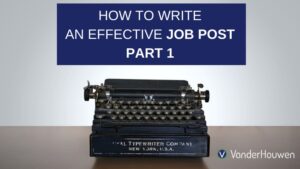The Cost of Making a Bad Hire
If you’ve ever been in a workplace where a bad hire was let go, you already may be familiar with the consequences—low morale, increased workloads, frustration, and even more turnover. And if you’re a hiring manager, the pressure and workload associated with a bad hire can feel like your responsibility.
And while you may have strategies in place to manage turnover, it’s always a good idea to ask—why do we make bad hires? What’s happening behind the scenes? As a staffing agency, we’ve seen it all. And we’re intimately familiar with what hiring managers are going through when they try to fill a position.
■ There’s a rush to hire: Whether or not a company is properly staffed, all the work still exists. This is true if a company is looking to replace a team member or if the company is growing and needs more staff to accommodate the workload. Hiring managers are constantly facing this challenge—their current staff is over-resourced and dealing with the burden of not getting the support they need, but the hiring process takes time. This puts a lot of pressure on hiring managers to get roles filled quickly and when there’s a rush to fill a position, mistakes can be made.
■ There’s a lot on the hiring manager’s plate: Staffing agencies take the time to properly vet their candidates—they get a deep understanding of their background, experience, and goals. That’s their entire job. Hiring managers, on the other hand, have a lot more on their plate to prioritize than staffing. They have their own workload, they’re managing others, they’re spread too thin. Sifting through resumes is incredibly time-consuming and a difficult task to balance.
■ Hiring managers aren’t experts at hiring. In addition to being time strapped with their own workload, the truth is—hiring managers aren’t recruiting professionals. Maybe they’re Software Engineers or they’re Controllers. When you don’t have years of recruiting experience, you can run into problems with hiring. You aren’t asking the right questions. You’re getting hung up on technical details that don’t actually matter—for example, job titles can mean vastly different things depending on the size of the company. You’re missing red flags.
When it comes to costs, let’s first look at the quantitative costs of making a bad hire. This is where hours—and therefore, dollars—are lost.
■ Hours spent planning: This is the beginning stage, where the hiring manager recognizes the need for a new candidate. They’re shifting things around, identifying opportunities, and creating job descriptions.
■ Money spent posting job descriptions: Uploading job descriptions to multiple sites like Indeed, Glassdoor, LinkedIn, and Monster costs money. And if you’re sponsoring those job ads, your costs can rack up to thousands of dollars.
■ Hours spent on interviewing: The hourly cost of all employees involved in the hiring process—this is time spent reviewing resumes, corralling schedules, phone interviews, group interviews, etc.
■ Onboarding costs: New hires need training, and all that training time means your employees aren’t being efficient. There’s a common statistic out there that says 25% of an employee’s first year salary is lost during the onboarding/training process. That’s how much productivity you lose.
■ Opportunity cost: Hiring managers and interviewers could have spent all the hours doing something else that’s actually their job.
■ Low morale and stress: Whenever there’s a hiring need, your employees are likely already dealing with low morale and stress. They’re putting in a lot of hours, likely doing two jobs, and are feeling the stress of their workload. When a bad hire is made, those feelings can amplify.
■ Turnover: Now, if you make a bad hire that ends up sticking around—or, if you fail to correct your hiring process and continue the pattern of making bad hires and letting them go, there can be serious consequences. This is especially the case if the bad hire is in a managerial position. If your candidate oversold themselves, or can’t do the job properly, there are a whole host of reasons that can cause negative feelings among your entire team. If that environment is negative enough, people will start to leave. And ultimately, when you have to let the original bad hire go, you can find yourself in a situation where you’re trying to replace multiple people instead of one.
■ A diminished company reputation: This is the final and most significant cost. Sites like Glassdoor have given company culture a front seat to anyone who is curious. If a bad hire turns into multiple bad hires, which then creates a negative company culture, which then results in turnover—you can bet that your disgruntled employees will leave you bad reviews. And, if the nature of your work is in client services, and your clients start to notice the repercussions of your hiring mistakes, word is going to spread. Don’t risk tarnishing your company’s reputation over an ineffective hiring process.
And while you may have strategies in place to manage turnover, it’s always a good idea to ask—why do we make bad hires? What’s happening behind the scenes? As a staffing agency, we’ve seen it all. And we’re intimately familiar with what hiring managers are going through when they try to fill a position.
Reasons a hiring manager may make a bad hire
Before we dive into the costs of bad hiring, it’s important to look at the reasons. Hiring managers are going through a lot—they’re strapped for time, they aren’t experts at recruiting, they’re dealing with a lot of pressure. When we look at reasons why a company may make a bad hire, a few top ones come to mind.■ There’s a rush to hire: Whether or not a company is properly staffed, all the work still exists. This is true if a company is looking to replace a team member or if the company is growing and needs more staff to accommodate the workload. Hiring managers are constantly facing this challenge—their current staff is over-resourced and dealing with the burden of not getting the support they need, but the hiring process takes time. This puts a lot of pressure on hiring managers to get roles filled quickly and when there’s a rush to fill a position, mistakes can be made.
■ There’s a lot on the hiring manager’s plate: Staffing agencies take the time to properly vet their candidates—they get a deep understanding of their background, experience, and goals. That’s their entire job. Hiring managers, on the other hand, have a lot more on their plate to prioritize than staffing. They have their own workload, they’re managing others, they’re spread too thin. Sifting through resumes is incredibly time-consuming and a difficult task to balance.
■ Hiring managers aren’t experts at hiring. In addition to being time strapped with their own workload, the truth is—hiring managers aren’t recruiting professionals. Maybe they’re Software Engineers or they’re Controllers. When you don’t have years of recruiting experience, you can run into problems with hiring. You aren’t asking the right questions. You’re getting hung up on technical details that don’t actually matter—for example, job titles can mean vastly different things depending on the size of the company. You’re missing red flags.
The quantitative costs of making a bad hire
With all these reasons in mind—a rushed process, a time-strapped hiring manager—bad decisions can be made. Maybe the candidate oversold their expertise, and it turns out they aren’t able to fulfill the role properly. Maybe their references or background weren’t properly vetted.When it comes to costs, let’s first look at the quantitative costs of making a bad hire. This is where hours—and therefore, dollars—are lost.
■ Hours spent planning: This is the beginning stage, where the hiring manager recognizes the need for a new candidate. They’re shifting things around, identifying opportunities, and creating job descriptions.
■ Money spent posting job descriptions: Uploading job descriptions to multiple sites like Indeed, Glassdoor, LinkedIn, and Monster costs money. And if you’re sponsoring those job ads, your costs can rack up to thousands of dollars.
■ Hours spent on interviewing: The hourly cost of all employees involved in the hiring process—this is time spent reviewing resumes, corralling schedules, phone interviews, group interviews, etc.
■ Onboarding costs: New hires need training, and all that training time means your employees aren’t being efficient. There’s a common statistic out there that says 25% of an employee’s first year salary is lost during the onboarding/training process. That’s how much productivity you lose.
■ Opportunity cost: Hiring managers and interviewers could have spent all the hours doing something else that’s actually their job.
The qualitative costs of making a bad hire
There are also a number of intangibles that exist when it comes to making a bad hire—this really comes down to employee morale, and ultimately turnover. Your current team is the one most negatively affected by a bad hire—they’re putting in the extra work to compensate, they’re re-interviewing, they’re re-onboarding. If it’s the case that the bad hire stays on the team, they’re dealing with the repercussions, lack of productivity, and lack of support.■ Low morale and stress: Whenever there’s a hiring need, your employees are likely already dealing with low morale and stress. They’re putting in a lot of hours, likely doing two jobs, and are feeling the stress of their workload. When a bad hire is made, those feelings can amplify.
■ Turnover: Now, if you make a bad hire that ends up sticking around—or, if you fail to correct your hiring process and continue the pattern of making bad hires and letting them go, there can be serious consequences. This is especially the case if the bad hire is in a managerial position. If your candidate oversold themselves, or can’t do the job properly, there are a whole host of reasons that can cause negative feelings among your entire team. If that environment is negative enough, people will start to leave. And ultimately, when you have to let the original bad hire go, you can find yourself in a situation where you’re trying to replace multiple people instead of one.
■ A diminished company reputation: This is the final and most significant cost. Sites like Glassdoor have given company culture a front seat to anyone who is curious. If a bad hire turns into multiple bad hires, which then creates a negative company culture, which then results in turnover—you can bet that your disgruntled employees will leave you bad reviews. And, if the nature of your work is in client services, and your clients start to notice the repercussions of your hiring mistakes, word is going to spread. Don’t risk tarnishing your company’s reputation over an ineffective hiring process.
With all that in place, how can you make sure you avoid making bad hires? Check out our follow up blog. In the meantime, check out our blog on what makes a great client-recruiter relationship.































































































































